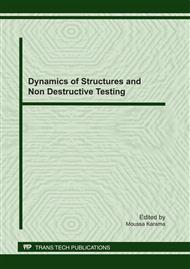p.11
p.21
p.31
p.39
p.49
p.57
p.67
p.79
p.89
Seismic Vulnerability Assessment Using the Instrumentation of an Existing Building
Abstract:
France is a country composed of moderate seismic hazard regions but however vulnerable to earthquakes. Indeed, only a few parts of existing buildings have been built using paraseismic regulation. Several current large-scale seismic vulnerability assessment methods are used, as Hazus or Risk-UE, but they are inappropriate to the analysis of a specific building. In our case, we use an experimental approach to study the elastic behaviour of existing buildings: ambient vibration analyses seem to be an interesting way to determine the vulnerability. Ambient noise testing with Output-Only Modal Identification is a low-cost non-destructive method to provide vibration data from civil engineering structures like buildings. The interest of this method is to obtain dynamic parameters with only natural excitations: wind, traffic, human activity... In the frame of the “Plan séisme des Hautes-Pyrénées”, the building considered is the relatively regular 18-storey Ophite Tower located in Lourdes, France. The vibration measurements are conducted using a 24-channel system connected to an acquisition station. The modal parameters of this building (natural frequencies, modal shapes and damping) are calculated using the stochastic subspace identification method. These parameters, extracted from in situ data, are then used to calibrate a model. Having defined damage level criterion, the response motion, produced by seismic events, will lead to the determination of the vulnerability curves of Ophite Tower.
Info:
Periodical:
Pages:
79-87
Citation:
Online since:
June 2011
Authors:
Price:
Сopyright:
© 2011 Trans Tech Publications Ltd. All Rights Reserved
Share:
Citation:


